Breeds of cattle & buffalo
Breeds of cattle & buffalo
Cattle Breeds
Indigenous dairy breeds of cattle
1. Gir
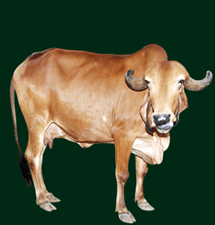
- This breed is otherwise known as Desan, Gujarati, Kathiawari, Sorthi, and Surati.
- Originated in Gir forests of South Kathiawar in Gujarat.
- Basic colours of skin are white with dark red or chocolate-brown patches or sometimes black or purely red.
- Horns are peculiarly curved, giving a ‘half moon’ appearance.
- Milk yield ranges from 1200-1800 kgs.
- Age at first calving 45-54 months and inter calving period from 515 to 600 days.
2. Red Sindhi
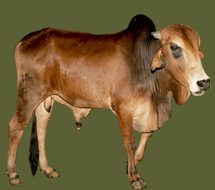
- This breed is otherwise called as Red Karachi and Sindhi.
- This breed mostly found in Karachi and Hyderabad district of Pakistan.
- Colour is red with shades varying from dark red to light, strips of white.
- Milk yield ranges from 1100-2600 kgs.
- Widely used in crossbreeding programmes.
- Age at first calving 39-50 months and inter calving period from 425-540 days.
3. Sahiwal
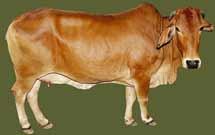
- Originated in Montgomery district in present Pakistan.
- This breed otherwise known as Lola (loose skin), Lambi Bar, Montgomery, Multani, Teli.
- The colour is reddish dun or pale red, sometimes flashed with white patches.
- The average milk yield of this breed is between 2,725 and 3,175 kgs in lactation period of 300 days
4. Deoni
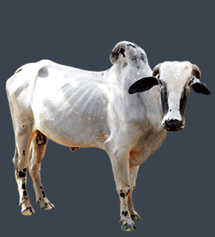
- This breed otherwise known as Dongerpati, Dongari, Wannera, Waghyd, Balankya, Shevera.
- Originated in Marathwada region of Maharashtra state and adjoining part of Karnataka and western Andhra Pradesh states.
- Body colour is usually spotted black and white.
- Age at first calving ranges from 894 to 1540 days with an average of 1391 days.
- Milk yield ranges from 636 to 1230 kgs with an average of 940 days.
- Caving interval averages 447 days.
Indigenous Draught breeds of cattle
1. Hallikar
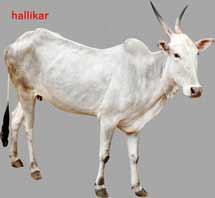
- Originated from the former princely state of Vijayanagarm, presently part of Karnataka.
- The colour is grey.
- They are compact, muscular and medium size animal.
- The breed is best known for its draught capacity and especially for its trotting ability.
2. Amritmahal
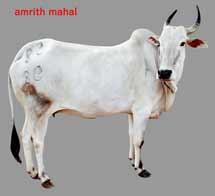
- Originated in Hassan, Chikmagalur and Chitradurga district of Karnataka.
- Amiritmahals are grey cattle but their shade varies from almost white to near black.
- Horns are long and end in sharp black points.
3. Khillari
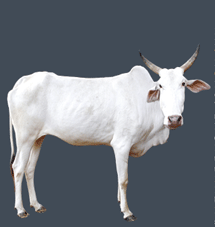
- Originated from Sholapur and Sitapur districts of Maharashtra.
- Grey-white in colour and have quick gait
4. Kangayam
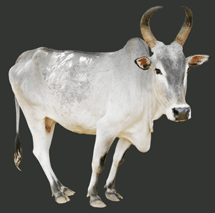
- Originated in Kangayam, Dharapuram, Perundurai, Erode, Bhavani and part of Gobichettipalayam taluk of Erode and Coimbatore district.
- The Kangayam breed was developed by the efforts of the late Pattogar of Palayakottai, Sri N. Nallathambi Sarkari Manradiar.
- Coat is red at birth, but changes to grey at about 6 months of age.
- Bulls are grey with dark colour in hump, fore and hind quarters.
- Bullocks are grey.
- Cows are grey or white. However, animals with red, black, fawn and broken colours are also observed.
- The eyes are dark and prominent with black rings around them.
5. Bargur
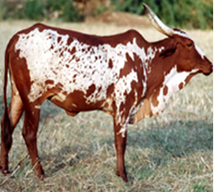
- Found around Bargur hills in Bhavani taluk of Erode district.
- Bargur cattle are of brown colour with white markings. Some white or dark brown animal are also seen.
- Animals are well built, compact and medium in size.
6. Umblachery
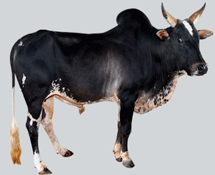
- It is otherwise called as Jathi madu, Mottai madu, Molai madu, Therkathi madu.
- Originated in Thanjavur, Thiruvarur and Nagappattinam districts of Tamil Nadu.
- Umblachery calves are generally red or brown at birth with all the characteristic white marking on the face, on limbs and tail.
- The practice of dehorning of bullocks is peculiar in Umblachery cattle.
7. Pullikulam / Alambadi
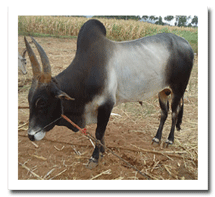
- This breed is commonly seen in Salem and Coimbatore district of Tamil Nadu and part of Bangalore district of Karnataka.
- Pulikulam / Alambadi bulls are dark grey, almost black and cows grey or white.
- They have the typical backward curving horns of Mysore type cattle.
- They are active, useful draught animals but not fast trotter.
Bachaur
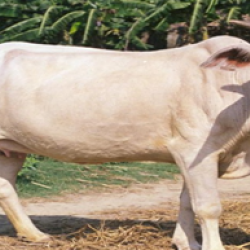
- Bachaur is draught breed of Bihar which also known as “Bhutia”.
- Colour : Grey
- Horn Shape & Size: Horns are stumpy, curving outward and upward. Medium in size
- Visible Characteristic: Medium sized compact animals with straight back. Forehead flat or slightly convex
Dagri
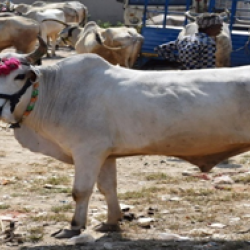
- Dagri Cow Dagri BullDagri is draught breed of Gujarat, also known as “Gujarat Malvi”. Dagri in colloquial language means 'Deshi' or old or native.
- Colour is predominantly white, sometimes with grey shade. Small sized animal with compact body and straight forehead. Body length is proportionally more than height.
- Horn are short, thin, curved upward in a lyre shaped or in straight fashion with pointed tip.
Himachali Pahari

- Coat colour is primarily black and blackish brown with compact cylindrical body, short legs, medium hump, horizontally placed ears and comparatively long tail..
- Horns are medium sized, mainly curved in lateral and upward direction. Size: Male- 16.1, Female- 12.9 cm.
Kenkatha
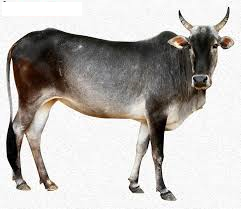
- Colour veries from grey on the barrel to dark grey on the rest of body.
- Horns emerge from the outer angles of the poll in markedly forward direction and terminate in sharp points.
- Small, sturdy and fairly powerful animal. Horns directed forwards.
Kherigarh
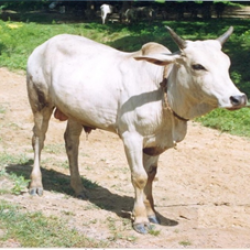
- Animals have white coat colour. Some animals have grey colour distributed all over body especially on face.
- Horns are upstanding, curving outward and upward. These are thick at the base. Horn formation is typical of lyre-horned Malvi type. Horns are medium in size (15 cm).
- Small but active animal.
Konkan Kapila
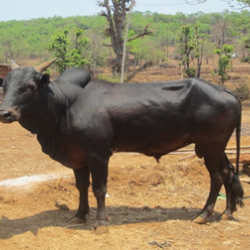
- Animals are of various coat colours, predominant being reddish brown followed by black. However white/grey, mixed, brown or fawn coat colour animals are also available.
- Small to medium sized and compact body, horizontal ears and straight forehead. Eyelids, muzzle, hoof and tail switch are generally black.
- Horns are generally straight. Emerge from side of the poll behind and above eyes in outward direction and going upwards and backwards ending with pointed tips. Male-18.45cm; Female-18.30cm.
Ladakhi
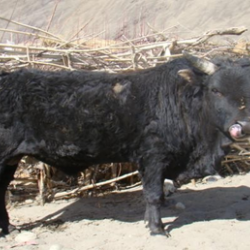
- Coat colour is mostly black followed by brown.
- Body is compact with short legs that make it more adapted to mountainous terrains.
- Small hairy, forehead with slightly long face and have small hump.
- Horns are curved, directed slightly upward and forward ending with pointed tips over the forehead. Average size: 16cm in male and 11cm in female.
- Well adapted to high altitude, extreme cold climatic and hypoxic conditions
Mewati
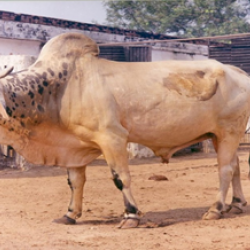
- Mewati cattle are usually white with neck, shoulders and quarters of a darker shade.
- Face is long and narrow with straight, sometimes slightly bulging forehead.
- Horns are outwards, upwards, inwards in majority of animals; and outwards and upward in some animals. Tips pointed. Small to medium in size.
Motu
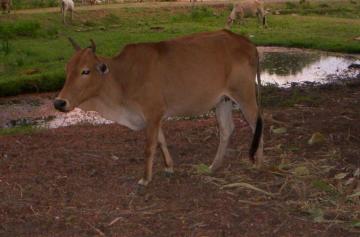
- Colour: Mainly Brown (Reddish) some times Grey. Few animals are white in colour
- Horn Shape &Size : Straight, Up ward with rounded tip. Male: 6.23±0.21, Female: 3.35±0.18cm
- Visible Characteristic : Small sized, strong and draft type cattle. Animals are mostly polled and brown in colour
Siri
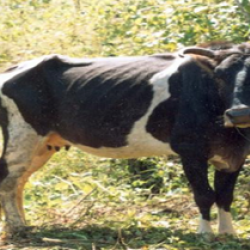
- Siri is a small sized draught purpose breed of hilly region of West Bengal and Sikkim. The breed is also known as “Trahbum”
- Colour: Animals are either black with white patches or Brown with white patches. In some cases they are totally black or brown.
- Horn Shape & Size: Horns are curved outward, forward and slightly upward, and are medium in size.
- Visible Characteristic: Colour pattern similar to that of Holstein Friesian, Cervico-thoracic type of hump.
Indigenous Dual purpose breeds of Cattle
1. Tharparkar
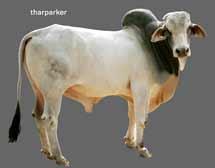
- Originated in Tharparkar district of southeast Sind in Pakistan.
- Otherwise known as White Sindhi, Gray Sindhi and Thari.
- Body colour is white or light grey.
- The bullocks are quite suitable for ploughing and casting and the cows are good milch animals (1,800 – 2600 kgs).
- Age at first calving ranges from 38-42 months and inter calving period from 430 to 460 days.
2. Hariana
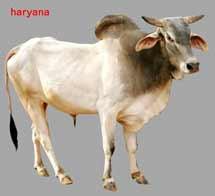
- It was originated from Rohtak, Hisar, Jind and Gurgaon districts of Haryana.
- Horns are small.
- The bullocks are good workers.
- Hariana cows are good milkers yielding on an average 1.5 kg/cow/day in a lactation period of 300 days.
- Average milk yield is 600 to 800 kgs per lactation. The age at first calving is 40-60 months.
4. Kankrej
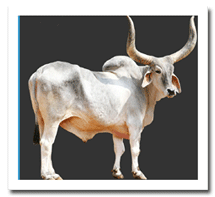
- It is otherwise called as Wadad or Waged, Wadhiar.
- Originated from Southeast Rann of Kutch of Gujarat and adjoining Rajasthan (Barmer and Jodhpur district).
- Colour of the animal varies from silver-grey to iron-grey or steel black.
- The gait of Kankrej is peculiar called as 1 ¼ paces (sawai chal).
- Kankrej is valued for fast, powerful, draught cattle. Useful in ploughing and carting.
- The cows are good milkers, yielding about 1360 kgs.
5. Ongole
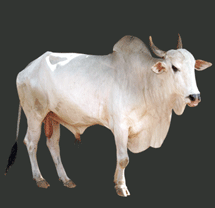
- Otherwise known as Nellore.
- Home tract is Ongole taluk in Gantur district of Andhra Pradesh.
- Average milk yield is 1000 kgs. Age at first calving is 38-45 months with an intercalving period of 470 days.
6. Krishna Valley
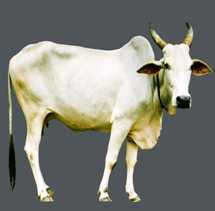
- Originated from black cotton soil of the water shed of the river Krishna in Karnataka.
- Animals are large, having a massive frame with deep, loosely built short body.
- Tail almost reaches the ground.
- Common colour grey white with a darker shade on fore quarters and hind quarters in male. Adult females are more whitish in appearance.
- The bullocks of this breed are powerful animals useful for slow ploughing, and valued for their good working qualities.
- The cows are fair milkers, average yield being about 916 kgs during the lactation period.
Badri
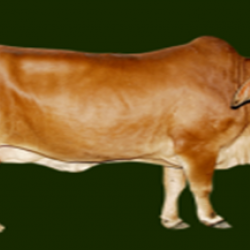
- Badri is dual purpose breed of Uttarakhand which also known as “Pahadi”; as they are mainly found in the hilly regions of Uttarakhand.
- Colour :Badri Cattle are small in size having varied body colours- Black, Brown, Red, White or gray.
- Horn Shape & Size: small in Size Having long Legs. Hump is prominent .udder is small in size, tucked up with the body.
- Visible Characteristic: Hump is prominent .udder is small in size, tucked up with the body. Hooves and muzzle are black or brown in colour.
Gaolao
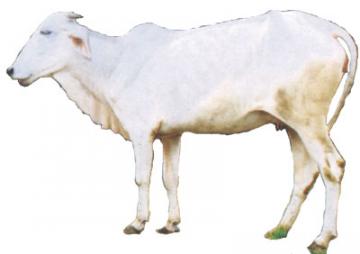
- Madhya Pradesh, District: Balaghat, Chhindwara, Seoni, Durg
- Colour: Gaolao animals are white or light grey. Males are generally grey over the neck
- Horn Shape & Size :Horns are short and stumpy, blunt at the points and curve slightly backward
- Visible Characteristic: Head markedly long and narrow tapering towards muzzle. Forehead recedes at the top giving a slightly convex appearance. Eyes almond shaped and placed slightly at angles.
Nari
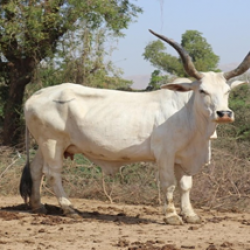
- Nari is dual purpose breed of cattle known as “Sirohi”.
- Coat colour varies from white or greyish white in colour in majority of animals and bulls are either white, greyish white or black.
- Body is medium in size.
- Horns are spirally curved & outward/ forward in orientation. Size: Male- 55.56, Female- 51.68 cm. Horns of males are mostly forwards in orientation (59%) whereas, the females has the horns mostly oriented outwards. Generally wide-spread, long, and thick at bottom and pointed at tips.
- Forehead is broad and slightly concave in majority of cases
Tharparkar
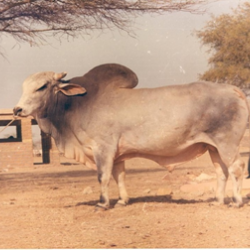
- Tharparkar (named after the Thar Desert in Rajasthan) is a dual purpose and disease resistant cattle breed. The breed is also known as “White Sindhi”, “Grey Sindhi” and “Thari” as per the place of its actual origin (Sind, Pakistan).
- Animals are white or light grey.
- Face is and extremities are of a darker shade than the body. These animals have convex forehead. In bulls neck, hump, and fore and hind quarters are also dark.
- Horns are set well apart curving gradually upward and outward in the same line as that of the poll, with blunt points inclined inward, moderatly thick at the base
Belahi

- Belahi breed of cattle are also known as Morni/ Desi.
- Colour: Red the face and lower abdomen and feet are White in colour with black muzzle.
- Horn Shape &Size :Curved upward and inward , sickle shaped.
- Characteristic: Medium sized strong dual type, and migratory animal of lower Himalayas. White face a long with some regions of Hump , neck, and dewlap are white. In males, Hump and neck region are dark in colour irrespective of coat colour.
Binjharpuri
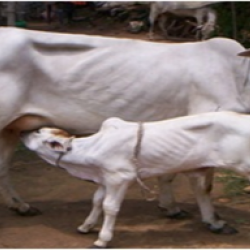
- Binjharpuri, also known as “Deshi”, is a breed of cattle found in Jajpur, Kendrapara and Bhadrak districts of Odisha, maintained for milk, draught and manure.
- Colour: White. Some animals are Grey, Black or Brown in Colour.
- Horn Shape & Size: Curved upward and inward.
- Average size in Male: 21.17±2.86, Female: 12.70±1.31cm
- Visible Characteristic: Medium sized, strong dual type animal. Hump, neck, and some region of face and back are black in colour irrespective of coat colour in males
Dangi
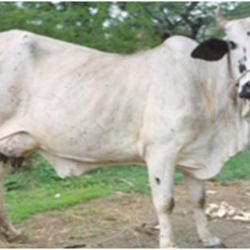
- Nashik, Ahmadnagar (Akola taluka of Ahmadnagar district, Sinner and Igatpuritaluka of Nashik districts) Generally these animals are found near the hilly tract where forest is available in the ranges of Sahyadri.
- Colour : Dangi cattle have distinct white coat colour with red or black spots distributed unevenly over the body
- Horn Shape & Size :Horns are short (12-15 cm) and thick with lateral pointing tips Animals with inward and also with downward pointing horn tips are also available in sizable numbers
- Visible Characteristic: Uneven distribution of black or red spots over the body. Forehead is slightly protruding
Gangatiri
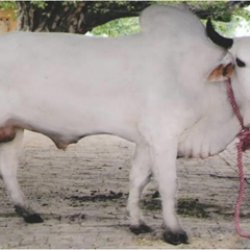
- Bhojpur district of Bihar, Varanasi, Mirzapur, Ghazipur, Ballia districts of Uttar Pradesh.
- Coat colour is complete white (Dhawar), Grey (Sokan).
- Horns are medium sized. Emerges from side of the poll behind and above eyes in outward and curving upwards and inwards ending with pointed tips.
- Forehead is Prominent, straight and broad with shallow groove in the middle. Eyelids, muzzle, hooves and tail switch are generally black.
Ghumusari
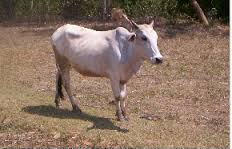
- Colour :Mainly White sometimes Grey
- Horn Shape & Size: Curved upward and inward. Some animals have straight horns.
- Male: 8.72±1.54, Female: 7.47±1.67cm
- Visible Characteristic: Small sized, strong and draft type animal. Small head with forehead being flat, broad and depressed in between the eyes
Lakhimi
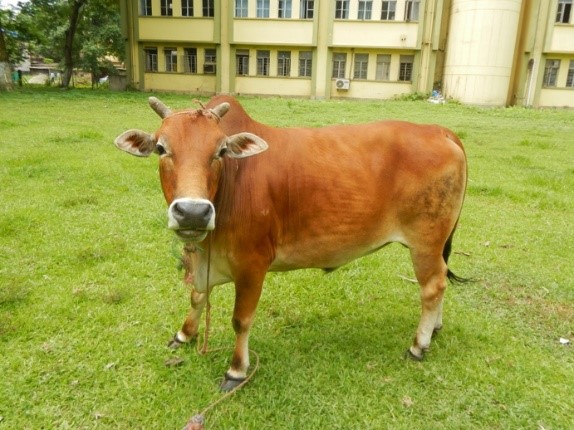
- Lakhimi is dual purpose breed of cattle is found in entire state of Assam.
- Brown & Grey coat colour. Animals are small sized, horned and have relatively short legs. Coat colour is variable mainly brown and grey. Hump is medium in size and the backline is slightly curved. Udder is small and bowel shaped.
Malnad
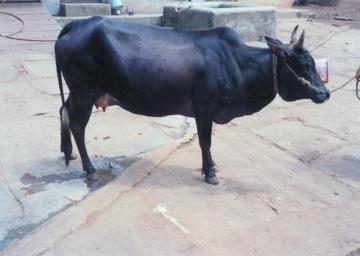
- Colour: black with light shades of fawn on thigh and Shoulder region
- Horn Shape &Size: Generally small and straight. Outward, upward and in ward
- Visible Characteristic: Gidda means dwarf and Malnad means a place receiving heavy rain fall. They are small in size with compact body frame weigh in garound 80-120 Kg. Tail switch - black, hump - small, udder small and bowl shaped.
Malvi
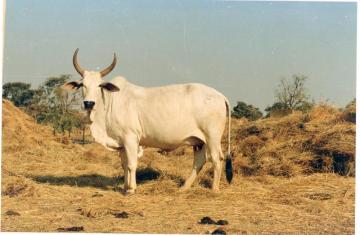
- Colour: Malvi cattle are grey- darker in males, with neck, shoulders, hump and quarters almost black. Cows and bullocks become nearly pure white with age
- Horn Shape & Size: Strong and pointed, emerge from the outer angle of the poll in an outward and up ward direction. Average Size of 20-25 cm in length
- Visible Characteristic: Strong well-built whitish grey animal with lyre shaped strong and pointed horns
Rathi
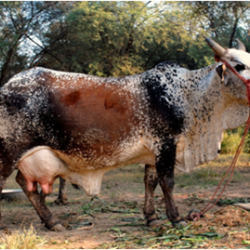
- Colour: The animals are usually brown with white patches Allover the body, but animals having completely brown, or black coat with white patches are often encountered. The lower body parts are generally lighter in colour as compared to the rest of body.
- Horn Shape & Size: Horns are curving out ward, upward and inward. Horns are short to medium in size.
- Visible Characteristic: Body colour and horns type
Red kandhari
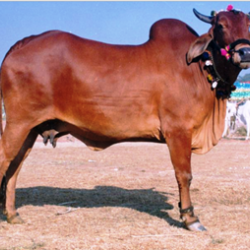
- Colour: The colour is uniform deep dark red, but varations From adullred to almost brown are also found. Bulls as a rule areas hade darker than cows.
- Horn Shape & Size: Horns are evenly curved and medium sized.
- Visible Characteristic : Body colour and horns type.
Shweta Kapila
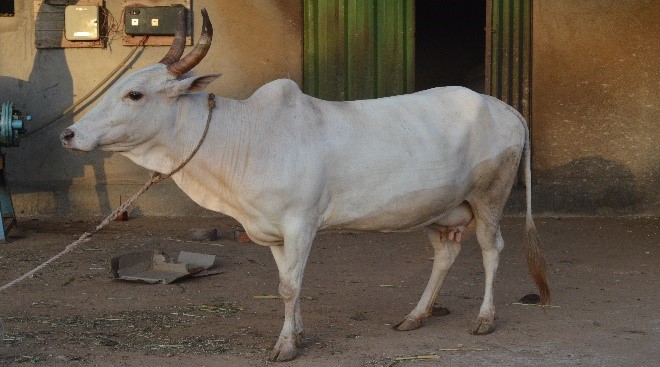
- Shweta Kapila breed of cattle is also known as “Gaunthi/Gavthi dhavi”.
- Coat colour is white.
- Horns are straight and maybe slightly curved upward and outward. Size: 20-27cm.
- White colour extends from muzzle to tail switch including eyelashes and muzzle (whitish brown).
- Short to medium statured animal with straight face and small to medium hump.
Thutho
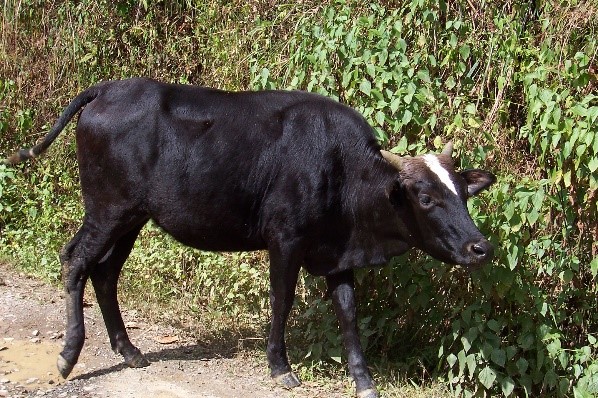
- Coat colour is black or brown, sometimes white patches on face and body.
- Medium in size, hardy, well-built and docile.
- Fore-head is small and straight. Backline is uneven, slopes behind the small hump, and rises to peak between hipbones and then drops sharply to the tail head
- Horns are curved outward and upward. Short and stumpy
Vechur
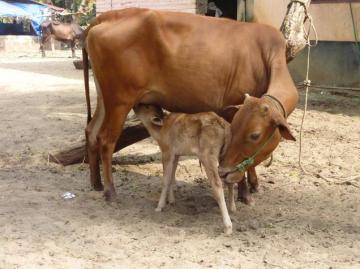
- Vechur is one of the dwarf cattle breeds of India, with an average length of 124 cm and height of 87 cm, it is considered to the smallest cattle breed in the world. It is known by the name of a place Vechur - a small place by the side of Vembanad lake near Vaikam in Kottayam district of South Kerala.
- Colour: Animals are light red, black or fawn and white
- Horn Shape & Size: Horns are small, thin curving forward and downward. In some cases they are extremely small and are hardly visible.
- Visible Characteristic: Extremely small sized animal
Exotic dairy breeds of cattle
1. Jersey
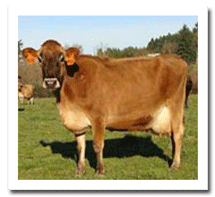
- It is the smallest of the dairy types of cattle developed on island of Jersey, U.K.
- In India this breed has acclimatized well and is widely used in cross breeding with indigenous cows.
- The typical colour of Jersey cattle is reddish fawn.
- Dished fore head and compact and angular body.
- These are economical producers of milk with 5.3% fat and 15% SNF.
2. Holstein Friesian
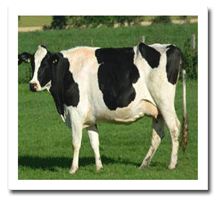
- This breed was developed in the northern parts of Netherlands, especially in the province of Friesland.
- They are ruggedly built and they possess large udder.
- They are the largest dairy breed and mature cows weigh as much as 700kg.
- They have typical marking of black and white that make them easily distinguishable.
- The average production of cow is 6000 to 7000 kgs per lactation. However, the fat content in their milk is rather low (3.45 per cent).
3. Brown Swiss
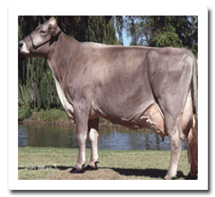
- The mountainous region of Switzerland is the place of origin of Brown Swiss breed.
- It is famous in its home tract for its rugged nature and good milk production.
- The Karan Swiss is the excellent crossbred cattle obtained by crossing this breed with recognized Indian breeds of cattle.
4. Red Dane
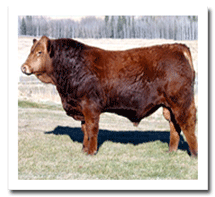
- The typical body colour of this Danish breed is red, reddish brown or even dark brown.
- It is also a heavy breed; mature males weighing up to 950 kgs and mature female weigh 600 kgs.
- The lactation yield of Red Dane cattle varies from 3000 to 4000 kgs with a fat content of 4 per cent and above.
5. Ayrshire
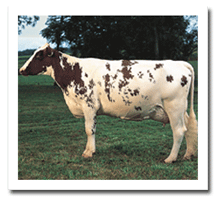
- Origin Ayrshire in Scotland is considered as most beautiful dairy breed. These are very active animals but hard to manage.
- They do not produce as much milk or butter fat (only 4%) as some of the other dairy breeds.
- The breed was also known as Dunlop cattle or Cunningham cattle.
6. Guernsey
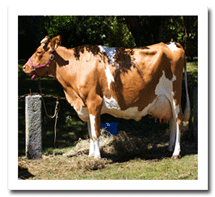
- Originated from Small island of Guernsey (France).
- The milk has a golden colour due to an exceptionally high content of beta carotene which may help to reduce the risks of certain cancers.
- The milk also has a high butterfat content of 5% and a high protein content of 3.7%.
- Guernsey cows produce around 6000 litres per cow per annum.
- The Guernsey cow has many notable advantages for the dairy farmer over other breeds includes high efficiency of milk production, low incidence of calving difficulty and longevity.
Buffalo breeds
Indigenous buffalo breeds
1. Murrah
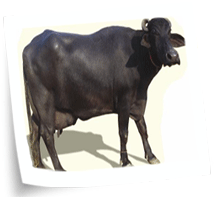
- It is the most important breed of buffaloes whose home is Rohtak, Hisar and Jind of Haryana, Nabha and Patiala districts of Punjab and southern parts of Delhi state.
- This is otherwise called as Delhi, Kundi and Kali.
- The colour is usually jet black with white markings on tail and face and extremities sometimes found.
- The tightly curved horn is an important character of this breed.
- The buffalo cows of this breed are one of the most efficient milk and butter fat producers in India.
- Butter fat content is 7%. Average lactation yield is varying from 1500-2500 kgs and the average milk yield is 6.8 kgs /day.
- It is also used for the grading up of inferior local buffaloes.
2. Surti
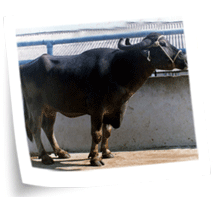
- The breeding tract of this breed is Kaira and Baroda district of Gujarat.
- Coat colour varies from rusty brown to silver-grey. Skin is black or brown.
- The horns are sickle shaped, moderately long and flat.
- The peculiarity of the breed is two white collars, one round the jaw and the other at the brisket.
- The milk yield ranges from 900 to 1300 kgs.
- The peculiarity of this breed is very high fat percentage in milk (8-12per cent).
3. Jaffrabadi
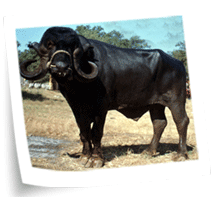
- The breeding tract of this breed is Gir forests, Kutch and Jamnagar districts of Gujarat.
- The horns are heavy, inclined to droop at each side of the neck and then turning up at point (drooping horns).
- The average milk yield is 100 to 1200 kgs.
- The bullocks are heavy and used for ploughing and carting.
- These animals are mostly maintained by traditional breeders called Maldharis, who are nomads.
4. Bhadawari
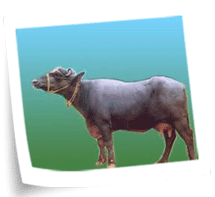
- Home tract of this breed is Agra and Etawah district of Uttar Pradesh and Gwalior district of Madhya Pradesh.
- The body is usually light or copper coloured is a peculiarity of this breed. Eye lids are generally copper or light brown colour.
- Two white lines ‘Chevron’ are present at the lower side of the neck similar to that of Surti buffaloes.
- The average milk yield is 800 to 1000 kgs.
- The bullocks are good draught animal with high heat tolerance.
- The fat content varies from 6 to 12.5 per cent. This breed is an efficient converter of coarse feed into butterfat and is known for its high butter fat content.
5. Nili Ravi
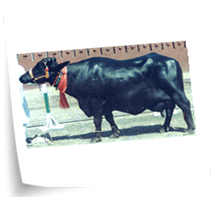
- This breed is found in Sutlej valley in Ferozpur district of Punjab and in the Sahiwal district of Pakistan. (Bred around Ravi river).
- The peculiarity of the breed is the wall eyes.
- The milk yield is 1500-1850 kgs per lactation.
- The intercalving period is 500-550 days and age at first calving is 45-50 months.
6. Mehsana
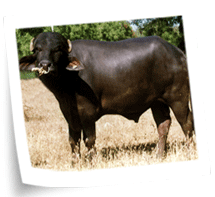
- Mehsana is a dairy breed of buffalo found in Mehsana town in Gujarat and adjoining Maharashtra state.
- The breed is supposed to have been evolved out of crossbreeding between the Surti and the Murrah.
- The milk yield is 1200-1500 kgs. The breed is supposed to have good persistency.
- The intercalving period ranges between 450-550 days.
7. Nagpuri
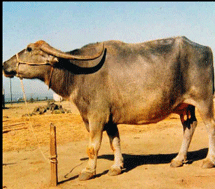
- The breeding tract of this breed is Nagpur, Akola and Amrawati districts of Maharashtra.
- These are black coloured animal with white patches on face, legs and tail. This is also called as Elitchpuri or Barari.
- The horns are long, flat and curved, bending backward on each side of the back. (Sward shaped horns).
- The age at first calving is 45-50 months with an intercalving period of 450-550 days.
8. Toda
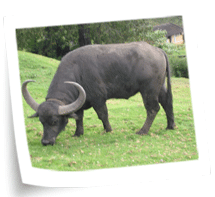
- Toda breed of buffaloes is named after an ancient tribe, Toda of Nilgiris of south India.
- The predominate coat colours are fawn and ash-grey.
- These buffaloes are quite distinct from other breeds and are indigenous to Nilgiris hills.
- Thick hair coat is found all over the body.
- They are gregarious in nature.
Banni
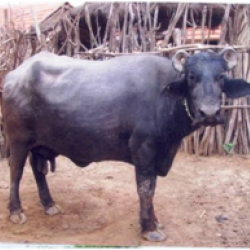
- Colour: Mainly Black, some times Copper colour
- Horn Shape & Size : Curved. Medium to large, heavy with 24 to 30cm diameter in adult animals
- Visible Characteristic : Horns are vertical and upward in direction with inverted double/single coiling
- Districts: Kachchh, Sabarkantha, Surendranagar, Kheda, Banaskantha
Bargur
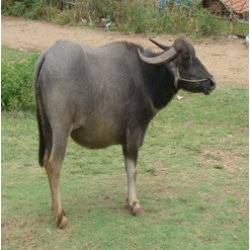
- Coat colors vary from black to light brown or brownish black. Greyish white stockings from carpal/tarsal joint to fetlock are present predominantly in females.
- These buffaloes are maintained under extensive system and are reared for manure, milk and meat (male calves are sold for cara-beef).
- The animals are adapted to graze in the hilly terrain due its small size (about 102cm in height).
- The milk yield of the animals ranges from 1.5 to 2.0 liters per day and mainly used for house hold consumption.
Chhattisgarhi
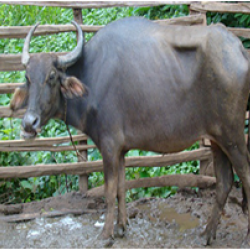
- Coat colour is black. Animals are medium built with proportionate body.
- Horns are medium to large in size and directed laterally backwards and then upwards with pointing tips.
- These buffaloes are reared under extensive system for providing draught power, milk and meat.
- Males have excellent ploughing ability, and preferred over cow bullocks specifically in rice fields.
- Milk yield ranges from 3 to 6 kg/day.
Chilika
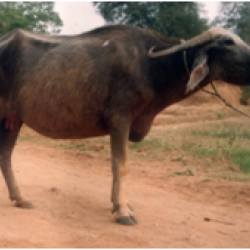
- Colour : Brown is hblack or Black
- Horn Shape & Size :Curved Upward, inward.
- Visible Characteristic: Medium sized with compact body, strong legs and small udder. Habitatis chilka lake
- Districts:Khurda,Puri, krishnaprasad, Panaspandhaand Ganjam
Gojri
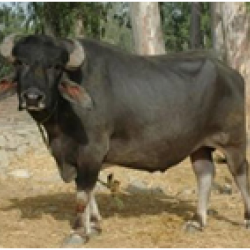
- These buffaloes have proportionate and medium built body and are mostly brown or black in colour. Horns are medium sized; mostly curved to form a big loop.
- Gurdaspur, Hoshiarpur, Rupnagar and SAS Nagar (Mohali) districts of Punjab and Kangra and Chamba districts of Himachal Pradesh
Kalahandi
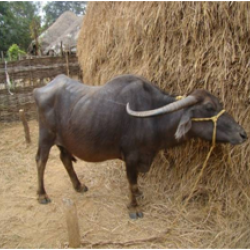
- Colour: Coat colour is usually a mix of black and grey, Some times grey
- Horn Shape & Size: Horizontal going backwards, upward, and inward, Curved to make half circle appearance. About 50 cm long
- Visible Characteristic: Muzzle, eyelids, tail and hoofs are black. Long horns. Head convex, udder round and medium in size. Tail extends below hock
Luit (Swamp)
.png)
- Luit is a medium sized black coloured buffalo with compact body and strong built up.
- Forehead is broad with conical face and wide muzzle. Eyes are prominent.
- Horns are broad at base, curved upward to form a semi circle and taper to a narrow tip.
- Light white stockings up to the knee are present in both fore and hind legs.
- Tail is short reaching up to the hocks.
- Udder is bowl shaped and small in size.
Marathwadi
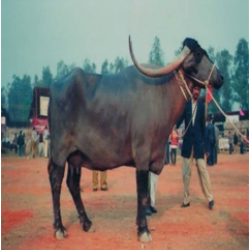
- Colour: Greyish black to jet black. Some animals have white Marking son forehead and lower parts of the limbs
- Horn Shape & Size: Horns are parallel to the neck, reaching up to shoulder but never beyond shoulder blade. Medium in length
- Visible Characteristic: Length of horns differentiates these buffaloes from Pandharpuri buffaloes. Horns reach up to the shoulder unlike in Pandharpuri buffaloes where these may reach up to pin bones some time
Pandharpuri
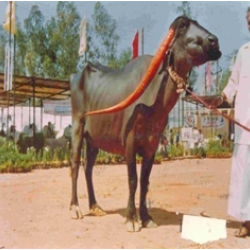
- Colour: Usually black but varies from light to deep black. White markings are found on fore head, legs and tail in few animals
- Horn Shape &Size: Horns are very long and extend beyond shoulder blade, some time suptopin bones. These are of three types i.e.1. Bharkand- curving back ward and usually twisted.2.Toki- curving back ward, upward and usually twisted out ward.3. Meti- flat running down
- Visible Characteristic: Very long horns. Nasal bone is very prominent ,long and straight
Source: Expert System for Cattle & Buffalo, TANUVAS & Vishwa Mangala Gou Grama Yathra
Related resources
Cattle Breeding Farms
Central Cattle Breeding Farms
|
Central Cattle Breeding Farm, |
Central Cattle Breeding Farm, |
|
Central Cattle Breeding Farm, |
Central Cattle Breeding Farm, |
|
Central Cattle Breeding Farm, |
Central Cattle Breeding Farm, |
|
Central Cattle Breeding Farm, |
|
State Cattle Breeding Farms
Himachal pradesh
- Cattle Breeding Farms, Department of Animal Husbandry, Himachal Pradesh
|
Cattle Breeding farm, |
Cattle Breeding farm, |
|
Cattle Breeding farm, |
Cattle Breeding farm, |
|
Cattle Breeding farm, |
- Sheep Breeding Farms, Department of Animal Husbandry, Himachal Pradesh
|
Cattle Breeding farm, |
Cattle Breeding farm, |
|
Cattle Breeding farm, |
Cattle Breeding farm, |
|
Cattle Breeding farm, |
- Rabbit Farms, Department of Animal Husbandry, Himachal Pradesh
|
Rabbit Breeding Farm, |
Rabbit Breeding Farm, |
Kerala
|
Cattle Breeding Farm, |
Livestock Research Station |
|
Centre for Pig Breeding & Research |
|
Karnataka
|
tate Livestock Breeding & Training Center, |
Livestock Breeding Farm, |
|
Hallikar Cattle Breeding Center, |
Livestock Research and Information Centre, |
Contact details of State Livestock Development Boards / Animal Husbandry Departments (13.3KB)
Last Modified : 12/8/2021
This topic covers information related to Acute res...
This page contains detail on indigenous dog breeds...
This topic provides information related to steps t...
This topic provides information about Zero tillage...
